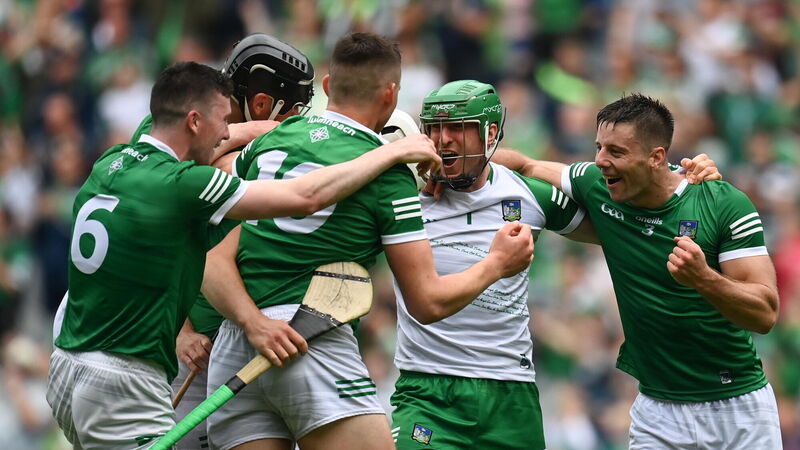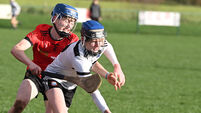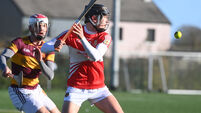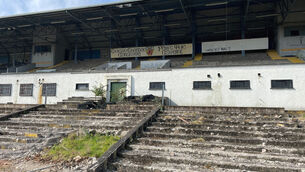Enda McEvoy: The identity of Limerick's nearest rivals is discernible solely by means of binoculars

Limerick players including Dan Morrissey and Nickie Quaid celebrate after the All-Ireland final win over Cork. Picture: Harry Murphy/Sportsfile
So after a Sunday on which a very good team became a great team and the most satisfying of summers concluded with a full orchestral performance by the champions, which one of the following were you?
Maybe you were one of those Limerick men who in their youth a quarter of a century ago crawled out of the rubble of Jones’s Road twice in three years and wondered if the sun would ever shine again. Now you’re middle-aged and your teenage offspring have twice been there in the past few years — it should have been three times, of course — to see the county win the All-Ireland. They can barely remember a day when the sun didn’t shine.
Maybe you were someone who spent most of the second half chatting to the man beside you in the Cusack Stand discovering mutual acquaintances. Yes: Limerick were so far ahead in an All-Ireland final that desultory conversation became the fallback. Is this the real life? Is this just fantasy?
Maybe you were someone who recalled running into Joe McKenna 10 years ago and heard him lay out his vision for the Limerick academy.
McKenna wasn’t talking about world domination or winning All-Irelands. His sole and scarcely highfalutin’ ambition was to put together a decent underage bunch Limerick could bring up to Croke Park. What they did when they got there — whether they won or lost — wasn’t the point. Getting to Croke Park, and getting back to Croke Park, and getting used to Croke Park: That was the point.
Maybe you were someone who happened to catch the early noughties instalments of over your tea during the week and goggled at the modest tallies posted by the MacCarthy Cup winners: 1-14, 0-17, 1-21, 1-16.
“But… but… Limerick scored 3-18 in the first half last Sunday!”
Maybe you were someone who happened to come across a photo of Cian Lynch from 2018 and was moved to compare it with a photo of him the other day. He is both the same man and not the same man. The hands of a concert pianist and the feet of a ballerina are now encased within the frame of a middleweight boxer.
Or maybe you were the Limerick manager and maybe you eventually got a little weary of the comparisons with Brian Cody and Kilkenny 2008, unavoidable though they were. You’d better get used to it. What Kiely Does Next is already one of the storylines for 2022. And in the same way that Cody wasn’t stopping after 2008, it can safely be assumed that neither is Kiely.
The identity of the champions’ nearest rivals is discernible solely by means of binoculars. This wasn’t quite true of Kilkenny 13 years ago; it was obvious that Tipperary, who’d won the National League and Munster titles in their first season under Liam Sheedy and who’d had the good sense to lose to Waterford in the All-Ireland semi-final, were the coming attraction. Thus it came to pass.
Cork, clearly, are on the way back. Equally clearly, they’re much farther off Limerick than Tipperary were off Kilkenny back then.
Not only are the rest of the pack much of a muchness, Galway and Tipp are both facing into a period of reconstruction, the latter under a new manager who may or may not choose to go through the panel like a dose of salts.
Championship 2021 marked the beginning of a changing of the guard. Galway have lost Joe Canning. Tipperary have lost Brendan Maher, with others to follow in due course. TJ Reid and Richie Hogan will not be seen in stripes too often again.
It is not simply that these counties will be losing brilliant players. They will also be losing guiding lights, presiding deities.
The best players set standards and examples. They dictate the tone and the tempo. Their departure robs a dressing room of practical know-how and institutional memory. Limerick will encounter no such issues next year.
The average age of their bench last Sunday was bang on 26. (The equivalent figure for Kilkenny in 2008 was 24.46.) It is reasonable to conclude that Kiely will give some thought over the winter to pruning his squad. Which lads are in danger of becoming permanent subs and therefore need to be moved on in the interests of good housekeeping?
Among Kilkenny’s fir ionad against Waterford in 2008 were not one, not two, but three future Hurlers of the Year in TJ Reid, Michael Fennelly, and Richie Hogan. Earlier the same afternoon Eoin Murphy, Conor Fogarty, and Walter Walsh won minor medals. The following Sunday the U21s completed the trifecta when beating Tipperary with an outfit that included Paul Murphy, Kieran Joyce, Lester Ryan, and Colin Fennelly as well as Reid and Hogan.
Moral of the story? Although the five in a row would be lost, the wheel hadn’t stopped turning. Kilkenny went on to claim four of the next five MacCarthy Cups. The subs and the youngsters from 2008 were the ones driving the bus.
If Limerick do not possess the same depth right now, what of it? Colin Coughlan, who was given a run in the closing stages on Sunday, Cathal O’Neill and Adam English look the next most likely. The pressure on them to make the grade ought to be alleviated by the fact that the county’s needs are not pressing. One newcomer a year for the next three years should suffice to keep the pot bubbling — easier said than done, perhaps, but none the less true for it.
Some other observations.
For the purposes of comparison the key statistics from Kilkenny’s performance in 2008 went as follows: 37 shots, two wides, one back off the upright, one saved, 33 scores.
So no, Limerick did not match Cody’s charges for sheer inhuman iciness, but finding the target with almost every shaft is among the few powers they do not possess and in any case is one that has not carried the remotest relevance this side of the 2019 All-Ireland semi-final.
Since that chastening but educational Saturday evening at Croke Park their championship record reads: Played nine, Won nine, Average winning margin 8.55 points. One can only wonder how long it will take before they once again find themselves in a contest so close that their wides may actually matter.
Readers who cannot get enough of Cian Lynch — and frankly, who among us can? — might reflect afresh on his role in Gearóid Hegarty’s opening goal. Twice Lynch had the opportunity to give a pass. Twice he checked himself. Only when he’d straightened the line and his inner satnav informed him the moment was right did he extract the pin from the grenade. (No clear striking motion, mind you).
The Patrickswell’s man redeployment at centre-forward has constituted the most far-reaching positional switch since Cody gave Henry Shefflin the number 11 jersey for the 2002 National League. There may be a lesson there. Deploy your best and brainiest player where he can do most damage as both scorer and string-puller. Lynch always floated like a butterfly. Now he stings like a hornet too.
In converting prototypical Munster rugby backrows into scoring machines Kiely and Kinnerk did Limerick a favour. In simultaneously ensuring a free spirit like Lynch was not disenfranchised by this process they did hurling a favour.
Serial winners are by definition shape shifters. Limerick went from being a pointscoring team in 2020 (one goal in five games) to being a goalscoring team in 2021 (eight goals in four). That’s one way of staying ahead of the peloton. How will they reinvent themselves in 2022? Can’t wait.










